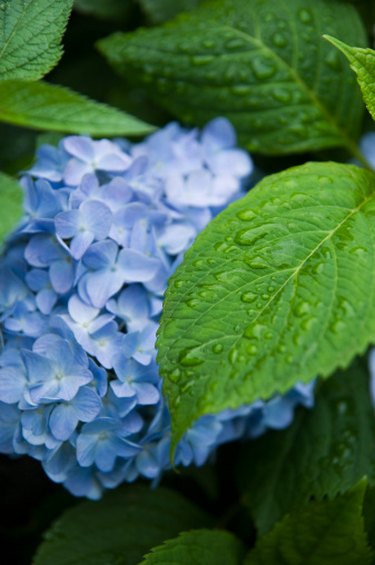
The soft-hued, full-blossomed hydrangeas adding texture and interest to your home garden may also attract a variety of white bugs. These bugs produce sticky, sugary honeydew on the hydrangea's leaves as they feed by sucking plant fluid. Honeydew promotes the development of sooty mold, a fungal infection that can cover plant surfaces with a black-hued mold, blocking out necessary sunlight. The initial step in avoiding pest problems is maintaining vigorous hydrangeas. Grow hydrangeas in morning sun and afternoon shade in well-drained soil.
Whiteflies
Video of the Day
Whiteflies are tiny white-to-yellowish flying bugs that attack hydrangeas as well as other ornamental plants. Gathering in groups beneath leaves, these sucking bugs quickly increase in population during warmer temperatures. As larger groups infest your hydrangeas, feeding results in the drying, yellowing and dropping of leaves. Whitefly infestations typically do not result in plant death except for extreme cases left uncontrolled, according to the University of California Integrated Pest Management Program. The best method of control is biological, as insecticides are not effective. Home gardeners should release natural enemies like predatory minute pirate bugs or lady beetles that hunt and kill whiteflies. Predatory insects are available in garden supply stores, catalogs and online.
Video of the Day
Cottony Camellia Scale
Cottony camellia scale, Pulvinaria floccifera, attacks hydrangeas as well as a broad range of other plants like maples, hollies and English ivy. As their name suggests, cottony camellia scales display cotton-like sacs which house their eggs. This sac is white and overtakes the presence of the scale itself, causing home gardeners to see what appear to be white bugs on their hydrangeas. As scales feed on hydrangeas, leaves drop, the plant declines and branch death often occurs. These sucking bugs must be controlled in their crawler stage, or the larval stage, just after hatching when scales are most active in movement. Cover affected plant surfaces with an application of insecticidal soap during the beginning of summer when crawlers are apparent .
Aphids
Aphids, commonly referred to as plant lice, are tiny bugs that infest hydrangeas as well as other host plants like jasmine, roses, gardenias and hibiscus. The aphids on your hydrangeas may look white as they are often covered in a waxy substance, and commonly display white markings. Other potential aphid colors include gray, black, orange, red, yellow, brown, green or blue-green. Aphids have short life spans, though their rate of reproduction is speedier than any other bug, according to the Texas Agricultural Extension Service. Though they die quickly, their large populations feed on nearly every part of your hydrangea plant, depending upon the species. Aphids often transmit saliva-carried viruses into plants while feeding, causing subsequent disease. Damage includes malformed and discolored leaves and stunted plant growth.
For control, the release of natural predators like green lacewing larvae or lady beetles offers effective control. Botanical pesticides like insecticidal soaps kill aphids on contact, though they do not provide residual control. Chemical insecticides with active ingredients like permethrin, endosulfan or carbaryl provide reliable management. Contact your local county extension agent or a licensed professional for assistance and a control program tailored to your particular infestation.
- Living with Bugs: Cottony Scale Insects
- Oregon State University Pacific Northwest Nursery IPM: Cottony Camellia Scale
- Clemson University Extension: Hydrangea
- University of California IPM Online: Hydrangea
- Texas Agricultural Extension Service: Aphids in Texas Landscapes
- University of California IPM Online: Whiteflies